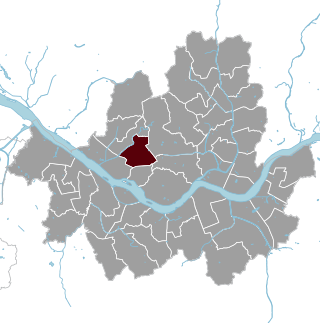Top Qs
Timeline
Chat
Perspective
Seodaemun A
Constituency in Seoul, South Korea From Wikipedia, the free encyclopedia
Remove ads
Seodaemun A (Korean: 서대문구 갑) is a constituency of the National Assembly of South Korea. The constituency consists of parts of Seodaemun District, Seoul. As of 2024, 130,042 eligible voters were registered in the constituency. The constituency was created in 1988 from the Seodaemun–Eunpyeong constituency.
Remove ads
History
Summarize
Perspective
Throughout its history, Seodaemun A has elected members of both liberal and conservative parties to represent the constituency. Accordingly, Seodaemun A has historically been considered a bellwether constituency by political analysts.[1] However, in recent elections the Democratic Party has been dominant with four consecutive wins in the constituency. Therefore, some analysts consider the constituency as becoming a stronghold for the Democratic Party.[2]
Kang Seong-mo of the right-wing Democratic Justice Party was the first member to represent the constituency having won with 37.04% of the vote.[3][4][5] Kang lost his bid for re-election and was succeeded by Kim Sang-hyun of the centre-left Democratic Party.[6] Kim won re-election in 1996 but was not re-nominated ahead of the 2000 election.[7] He was succeeded by Lee Sung-heon of the centre-right Grand National Party who won in a tight race against Woo Sang-ho of the Millennium Democratic Party.[8] Lee Sung-heon and Woo Sang-ho would continue to face off in rematches in Seodaemun A as the mainstream conservative and liberal party candidates respectively until the 2020 South Korean legislative election.[9][10]
In the 2004 South Korean legislative election, Woo Sang-ho of the Uri Party narrowly defeated incumbent Lee Sung-heon by a margin of 1,899 votes.[3][11][12] However, in the following election held in 2008, Lee won the seat back by a wide margin and securing 51.64% of the vote.[3][13][14] In the 2012 election, Woo won the seat back, securing 54.36% of the vote in a one-on-one battle against Lee Sung-heon.[3][15][16] Woo won re-election in 2016 and 2020 with 54.88% and 53.24% of the vote respectively, defeating former assemblyman Lee Sung-heon in both matches.[3][17][18][19][20]
Ahead of the 2024 South Korean legislative election, Woo Sang-ho announced that he would not be standing for re-election in Seodaemun A.[21] After holding a party primary, the Democratic Party nominated lawyer Kim Dong-ah as the party's candidate for the constituency on March 11, 2024.[22][23] Kim Dong-ah went on to win the general election with 50.75% of the vote, defeating Lee Yong-ho of the People Power Party.[24]
Remove ads
Boundaries
The constituency encompasses the neighborhoods of Hongje 1-dong, Hongje 2-dong, Bugahyeon-dong, Cheonyeon-dong, Chunghyeon-dong, Sinchon-dong, and Yeonhui-dong. It borders the constituencies of Seodaemun B to the north, Mapo B to the west, Mapo A to the south, Jung–Seongdong B and Jongno to the east.[25]
List of members of the National Assembly
Election results
2024
2020
2016
2012
2008
2004
2000
1996
1992
1988
Remove ads
See also
Notes
- member of the Democratic People's Party from February 27, 2000
References
Wikiwand - on
Seamless Wikipedia browsing. On steroids.
Remove ads

